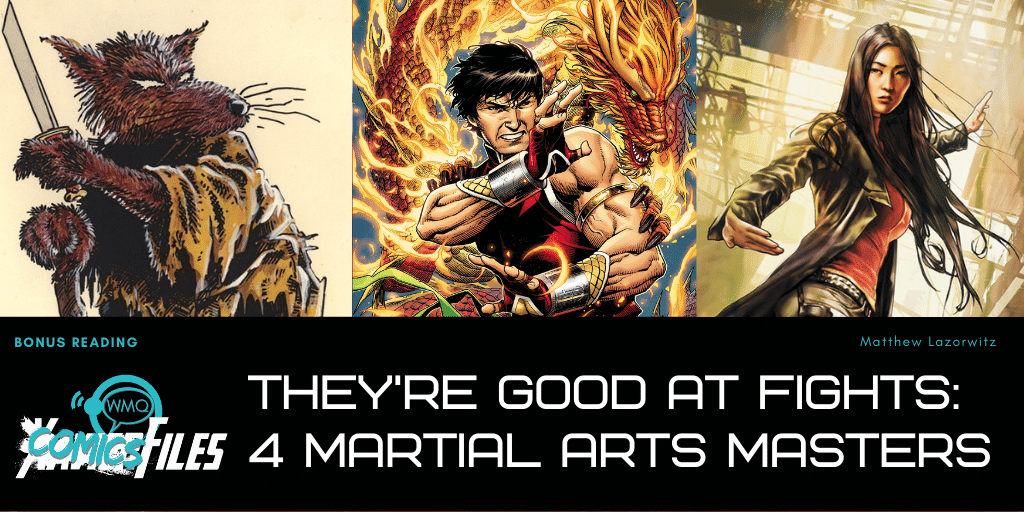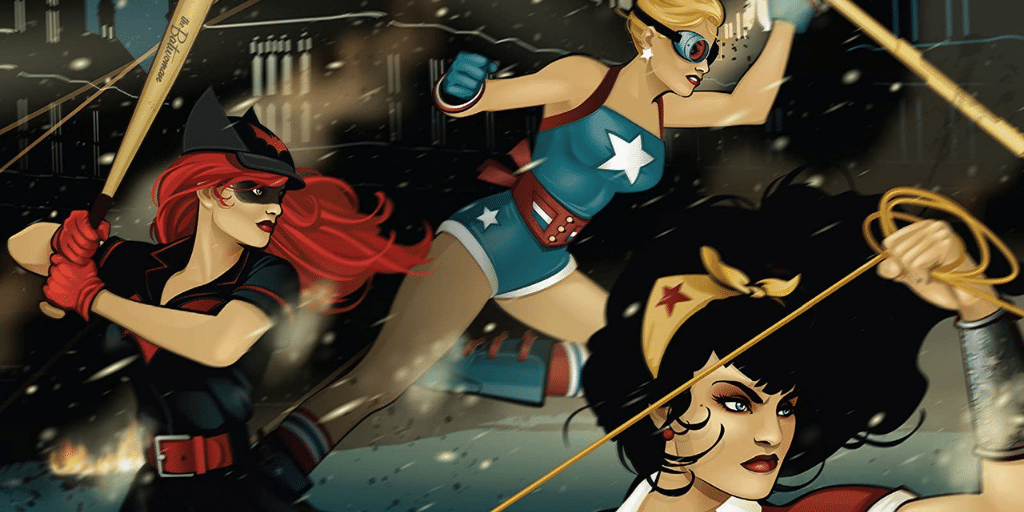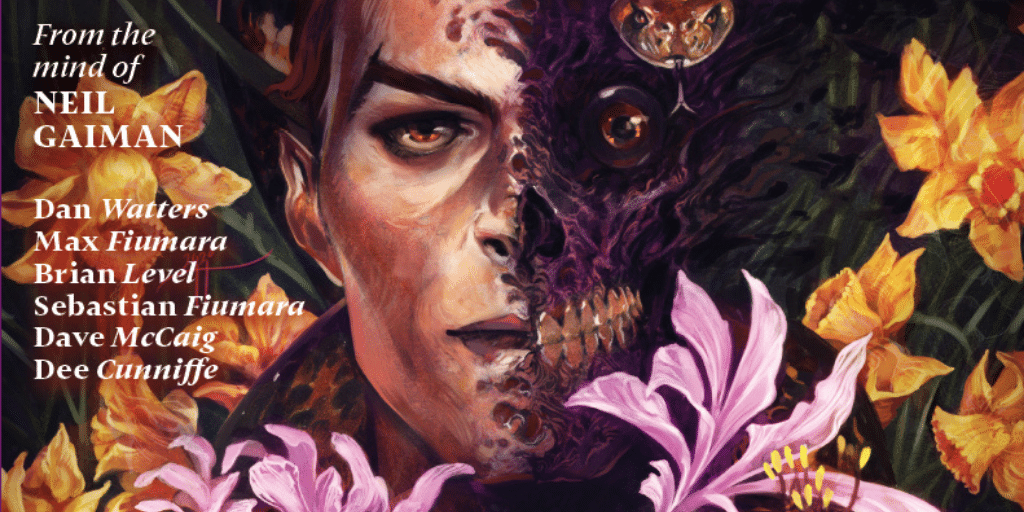Since the 1970s and the boom of martial arts media, the martial arts master has become a standard trope in comics. Ninjas, samurai, karate fighters and kung-fu masters have been present in comics from a myriad of companies. In many cases, they are portrayed through the lens of a white creator and with a problematic white-savior type lead, but this week, Marvel released a miniseries starring soon-to-be movie star (we hope, anyway) Shang-Chi from a team of creators of Asian descent. So this week’s Bonus Reading will focus on four of comics’ leading martial arts heroes.
Shang-Chi

Shang-Chi was created by Steve Englehart and Jim Starlin in 1973’s “Special Marvel Edition” #15. He was actually created as part of a licensed world, in this case that of Sax Rohmer’s yellow peril villain, Fu Manchu. Marvel had a habit in the ’70s and ’80s of working original characters and tie-ins to their own universe into licensed books, with other examples being Dum-Dum Dugan and S.H.I.E.L.D. hunting Godzilla, Spider-Man showing up in Transformers comics and Rom, the Spaceknights of Galador and their foes the Dire Wraiths popping up in many Marvel comics.
Shang-Chi was created as the son of Fu Manchu, who stood against his evil father and his criminal empire. He started out believing his father to be working for the betterment of humanity, but upon learning the true nature of Fu Manchu, he teamed up with his father’s enemies and fought against him. “Special Marvel Edition,” which was a reprint title before the two Shang-Chi issues, changed its name to “The Hands of Shang-Chi: Master of Kung-Fu.” The series survived the fading of the martial arts boom of the ’70s and ran for 125 issues until 1983, mostly under the pen of writer Doug Moench, and famously with art by Paul Gulacy. Fu Manchu remained the main villain for much of the series, finally dying in issue #118, but Shang-Chi developed a place in the Marvel Universe in the series as well.
After the series ended, Shang-Chi continued to pop up occasionally in team-ups with other heroes and in events.The character underwent something of a renaissance in the early ’00s, first appearing in “Heroes for Hire.” He would join up with MI-13 to fight a dragon and start training the young man who would become another ’70s Marvel character, Killraven. But it was Ed Brubaker’s “Secret Avengers” that would make him a larger player again, and would establish his father not to be Fu Manchu, as Marvel no longer had the rights to him, but a new character, an ancient Chinese sorcerer named Zheng Zu. Since then, Shang-Chi has appeared regularly, not just as an Avenger, but as a trainer of heroes who need to learn inner peace and new skills, in books like “Amazing Spider-Man” and “Domino.”
If all goes well, Shang-Chi’s big screen debut, “Shang-Chi and the Legend of the Ten Rings,” will be released in July 2021.
Lady Shiva

Among the myriad expert martial artists in the DC Universe, none is as feared as Sandra Woosan, better known as Lady Shiva. A member of the League of Assassins, Shiva has traveled the world as a mercenary, but more important to her is proving she is the best fighter in the world, challenging martial artist after martial artist to duels to the death. And while she has been fought to a standstill by many popular characters, few can claim a clean victory against her.
Created in “Richard Dragon, Master of Kung Fu” #5 by Denny O’Neil and Ric Estrada, Shiva was an assassin hunting for the man who killed her sister, a man she falsely believed to be Dragon. After she found out the truth and found the killer was already dead, she joined with Dragon briefly. Her post-Crisis origin is slightly different, making David Cain the killer of Shiva’s sister, and adding her connection to the League of Assassins as part of her origin, versus something she encountered later in life.
Still, Shiva would stay removed from the mainstream DC Universe for many years. After appearing in “Richard Dragon,” she would stay one of O’Neil’s trademark characters, appearing in his legendary run on “The Question” with Denys Cowan. She would encounter Batman for the first time in a crossover between “The Question,” “Green Arrow” and “Detective Comics” annuals, but being these were mature-readers books, they were tied only tangentially to the main DCU.
Shiva’s first serious interaction with the DC Universe, not counting a very brief appearance in “A Death in the Family” as one of the women who was potentially Jason Todd’s mother, was in the first Robin miniseries starring Tim Drake, where she helped train Tim on his journey abroad. From there, Shiva would develop a contentious relationship with the Bat-family, sometimes serving as ally, as when she helped retrain Batman after Bane broke his back, to enemy, as when she took part in the tournament of the Cult of the Monkey’s Fist as the Paper Monkey and nearly killed Connor Hawke.
Shiva’s relationship as a character in the orbit of the Batfamly was cemented with the revelation that she was the mother of Cassandra Cain, then Batgirl. The two fought, and Cassandra was the first to score a decisive victory over Shiva in combat. She would go on to briefly join the Birds of Prey, helping to train Black Canary in her development as a martial artist.
In recent stories, Shiva has focused often on her relationship with her daughter. She appeared during James Tynion IV’s run on “Detective Comics” as the leader of the League of Shadows, a particular sect of the League of Assassins. She has been a recurring character in, and recent member of, the Outsiders in “Batman and the Outsiders,” where she has been training Cassandra, now Orphan, and the Signal, Duke Thomas. With that series wrapping up in October, we’ll see where Shiva goes next.
Splinter

If you’re looking for the best martial arts dad and trainer in comics, you can look no further than the sewers of New York and a giant rat. And I say this as someone who is deathly afraid of rats. Master Splinter is the father figure for the Teenage Mutant Ninja Turtles, the person (if that is attributable to bipedal rats. Being seems more grammatically correct but doesn’t feel right either) who trained them in the art of ninjutsu, but also to be the heroes they are.
Discussing the origins and history of any character in the TMNT franchise is a challenge, as each incarnation takes a slightly different twist to the same basic story. In nearly all of his incarnations, Splinter is deeply entwined with a martial arts master named Hamato Yoshi. In some versions (the original Eastman/Laird comics, the ’90s films and the 2003 TV series), Splinter is the pet of Yoshi, mutated into a half-man/half rat by mutagen. In others (the 1987 and 2012 cartoons), it is Yoshi himself who is mutated into a man-rat. And in the current IDW series, he is the mutated rat who is the reincarnation of the original Yoshi.
Regardless of the incarnation, Splinter is a master of the martial arts, and is the best rat-dad ever. He loves his turtle sons, and does his best to train them not just in the physical aspects of the martial arts but the mental and spiritual aspects as well. He shows no favoritism to one turtle over the other, loving the loyal and doting Leonardo as much as the standoffish Raphael.
Green Turtle

The Green Turtle is not a household name. He’s a fairly obscure Golden Age hero who appeared only a handful of times. He wasn’t really a martial artist in those early appearances in the strictest sense of the words. He was a masked hero who fought with his fists, sure, but in the ’40s, no one was talking about fighting styles. What the Green Turtle was, though, and what makes him deserving of this list, is the first superhero of Asian descent.
If you look at the history of the Green Turtle, you’ll see that my above statement is a bit of an exaggeration. The Green Turtle is never shown unmasked in his few Golden Age appearances in “Blazing Comics.” But it is something of an open secret in comics’ scholarship circles that creator Chu F. Hing, himself of Chinese-American ancestry, wanted to create the first Chinese-American superhero. The publishers were nervous about this, so Hing never showed the Green Turtle unmasked as a choice or a protest, to maintain the choice he made.
When Gene Luen Yang, the writer of this week’s Shang-Chi miniseries, came to comics, one of his first projects was a Green Turtle miniseries with artist Sonny Liew. “The Shadow Hero” is an amazing work of historical fiction and retconning, expressly giving the Green Turtle the identity Hank Chu, an origin that tied into Chinese mysticism and some martial arts training.
The book is not just a tale of heroism and confronting the racism around you but is genuinely funny in a lot of places, including when Hank’s mother, who desperately wants her son to be a superhero, finds out that the newest hero, named for some kind of rodent, probably doesn’t even have powers, but instead is just really well trained. So she goes to an old boyfriend of hers, Wun Too, and tells Hank he will train the young man in kung-fu. Hank does learn martial arts, although Wun Too laughs off kung-fu, telling Hank he’s teaching him how to win a fight.
If you are curious about this week’s Shang-Chi series, or have enjoyed any of Yang’s DC work on “Superman” or “New Super-Man,” do yourself a favor and track down “The Shadow Hero.” It’s possibly my favorite thing Yang has written, and is an example of what a great creator can do with an underdeveloped character.
Honorable Mentions (and White Guys)

When creating this list, I actively chose to avoid characters who typified the cultural appropriation and white savior archetypes many martial artists in comics exemplify. But a lot of these characters exist, and some of them are really good characters, even with their more problematic natures.
Most famous is probably Iron Fist, star of comics and small screen. Danny Rand was trained in a mystical Shangri-la type city, K’un L’un, where he proved to be the best martial artist and gained the power of the Iron Fist. He returned to the wider world, and has been a fixture of the Marvel Universe for decades now, usually teamed up with his buddy Luke Cage, who is the survivor of another ’70s trend, blaxploitation. There’s also most of the Frank Miller Daredevil-related characters, including Elektra, Stick and the Hand.
DC has a massive number of martial artists, from most of the Batman family, to the Question, to Black Canary, but the most notable to fall into this trope is Richard Dragon, who was created to be DC’s main kung-fu hero in the ’70s. He teamed with Ben Turner, an African-American martial artist, who would go on to become Bronze Tiger, a brainwashed member of the League of Assassins who would seek redemption as a member of the Suicide Squad. His creator, Denny O’Neil, would return to Dragon in many of the same stories he would use Lady Shiva in, and Dragon even had a short-lived second series in the early ’00s. The original Dragon series is finally being reprinted in a single-volume hardcover at the beginning of 2021.
Finally, we have my perpetual also-ran, Ninjak. I like Ninjak a lot as a character, actually. He’s part James Bond, part Batman, part martial arts master. He’s a Valiant comics character, an agent of MI-6 with crazy tech and amazing martial arts skills. This is my third list where Ninjak came up as a possibility and fell off for characters better suited: the first being a Valiant characters 101 piece and the second last week’s sword bearers column, so I thought I might as well toss him in here, because he is a really fun character.
Matt Lazorwitz read his first comic at the age of 5. It was Who's Who in the DC Universe #2, featuring characters whose names begin with B, which explains so much about his Batman obsession. He writes about comics he loves, and co-hosts the podcasts BatChat with Matt & Will and The ComicsXF Interview Podcast.






